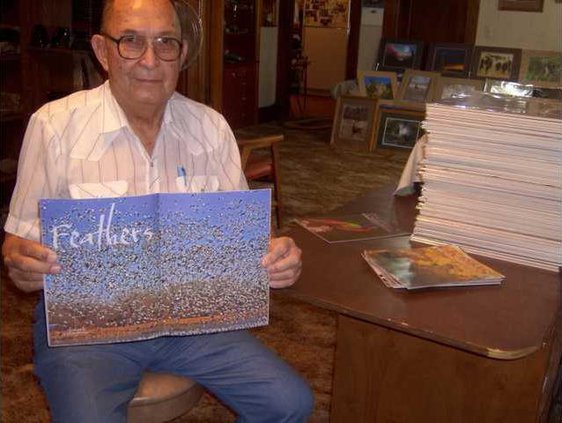Jim Glynn of Great Bend estimates he’s taken more than 200,000 wildlife and nature photographs, most of them from inside his gray Jeep Grand Cherokee.
“All of my photography is out of a car,” Glynn said. “It’s as good as any blind. You see more wildlife when you keep on the move than if you’re sitting and hoping some comes by.”
Glynn, 79, a retired building superintendent for the federal government, got interested in photography in 1988. He bought his first camera in 1959 – a Minolta with auto-focus – but has moved on to better ones.
“I’ve updated quite a ways since then,” he said.
In 2003, he switched from film to digital photography.
“There’s no comparison,” he said. “With all the programs available, film is practically dead. If you think of all the film and developing, that’s a lot of money.”
In addition to taking the photographs and editing them, Glynn also has the capability to print up to 13 by 19 inch prints, and does his own matting. He has a stack of more than 100 matted prints, which he sells via word of mouth.
He’s photographed everything from a herd of buffalo to a single gopher, throughout Kansas, Texas and Colorado. He’s had his photographs published on state and national park websites, in Kansas Wildlife & Parks magazine, Kansas Outdoor Today and Texas Sporting Journal.
Most good-weather days will find him on the road, searching for critters of all kinds.
“You just go out and hope you’ll find something,” he said. “You never know what you’ll run into. It depends on the weather. If it’s hot or if it’s very windy, I don’t go out. I have pretty good luck in the winter time.”
His photographs of a herd of buffalo happened accidentally in Colorado. He was actually looking for moose and stumbled onto a ranch in the middle of nowhere.
“I shot those over the top of my car,” he said.
One of the most challenging creatures he’s photographed is a bobcat.
“Most of the ones I’ve taken of bobcats are blurred or at sundown. Usually they’ll cross the road running or they take off,” he said. “But I have a few pictures of a baby bobcat.”
His favorite photo is one he took of a wood duck with its wings spread out. A unique one shows a pheasant and quail side by side.
Glynn has always loved nature and prior to photography, was an avid rock collector.
“I had a 24 by 32 building that was half used for working with rocks and the other half for display,” he said. “They filled a shed from floor to ceiling.”
As he shows individual photographs he’s taken, he has a comment for each one: “Look at that jack rabbit, his tongue is sticking out. That’s a ptarmigan. When it comes winters, it will turn entirely white. These barn owls have raised chicks in the barn here for the past six years. It’s hard to get a picture of a peregrine falcon because they’re always flying.”
Glynn spends a few hours at a time looking for wildlife, sometimes at Cheyenne Bottoms Wildlife Area, sometimes at Quivira National Wildlife Refuge, and sometimes elsewhere in the state.
He admits there’s not formula for getting a good shot.
“A lot of it is accidental,” he said.
A LOT OF IT IS ACCIDENTAL
Local wildlife photographer shoots from his car





